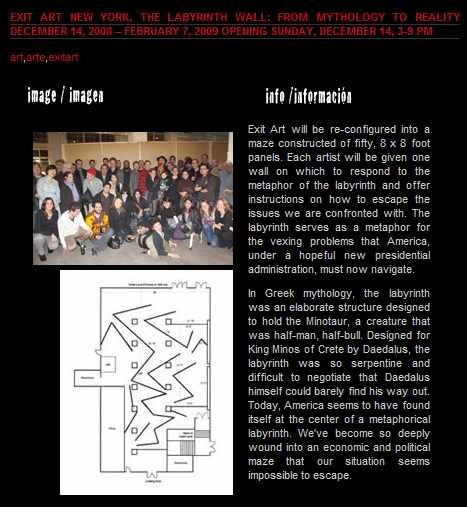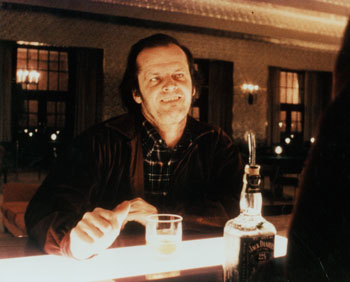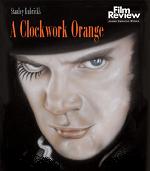
Halle Berry as Rosetta Stone:
From http://msa-x.msa-x.org/?p=1064 —
"Exit Art New York, The Labyrinth Wall:
From Mythology to Reality" —

From tonight's online New York Times obituaries —
Ms. Ingberman died Wednesday. Related material—
Symmetry (Wednesday), Design (Thursday), Solomon's Labyrinth (Friday).
See also an essay by John Haber —
"Exit Art may yet offer an alternative: shut them up in the labyrinth, with the Minotaur and, as in Iraq, no Ariadne's thread to guide them out. Jeannette Ingberman and Papo Colo line the space with 'The Labyrinth Wall: From Mythology to Reality,' inviting fifty-one artists to cover its sixty-two panels."
— "Marlene Dumas, The Labyrinth Wall, and Emily Jacir"
Haber (ibid .) also describes artist Marlene Dumas, a recent winner of a Royal Swedish Academy Schock Prize. For a fellow Schock winner— mathematician Michael Aschbacher— see Thursday's Design.)
* For another version of the title, see this morning's front page.
The New York Times at 8:22 PM ET —
"Knight Landesman, a longtime publisher of Artforum magazine
and a power broker in the art world, resigned on Wednesday
afternoon, hours after a lawsuit was filed in New York accusing
him of sexually harassing at least nine women in episodes that
stretched back almost a decade."
See as well, in this journal, Way to the Egress.
The Finkelstein Talisman —
"Before time began, there was the Cube."
— Optimus Prime in "Transformers" (Paramount, 2007)
Wikipedia on Hasbro —
Three American Jewish brothers,[6] Herman, Hillel, and Henry Hassenfeld[7]
founded Hassenfeld Brothers in Providence, Rhode Island in 1923 . . . .
The Hassenfeld Auction —
Also on September 16, 2015 —
The Hindman Image —
The Hood Warenkorb —
Under the Hood —
Megan Fox in "Transformers" (2007) —
This Way to the Egress —
New York Times headline about a death
on Friday, March 3, 2017 —
René Préval, President of Haiti
in 2010 Quake, Dies at 74
See also …
This way to the egress.
For a memorable eccentric who reportedly died
on Wednesday, July 24, 2013—
Last night's 9:29 PM (ET) post featured the phrase
"This way to the egress."
Last night's 10 PM post featured two deaths:
The author of The Best Christmas Pageant Ever
reportedly died at 85 on Tuesday, July 9.
A former director of the Museum of Modern Art
who was famously shown the exit door there
in his younger years reportedly died at 80 on
Saturday, July 6.
For a sort of pageant combining Christmas,
the Museum of Modern Art, and an egress,
see St. Stephen's Day, 2008.
Cafe Society Part I –
Jack Torrance at
the Overlook Hotel:

Cafe Society Part II –
Don Imus at The FanHouse,
Friday the 13th:

Cafe Society Part III –
The Bank Dick at
the Black Pussy Cafe:
“Which way to the egress?”
'Year of Magical Thinking'
Headed for Broadway
which suggests…
Heaven, Hell,
and Hollywood
(continued)
"This could be Heaven
or this could be Hell."
— The Eagles, Hotel California
"There are no facts,
there is no truth–
just data to be manipulated."
— Don Henley, The Garden of Allah
Data:
The New York Lottery numbers
on Joan Didion's birthday,
Monday, Dec. 5, 2005, were
Since that day's Log24 entry,
Magical Thinking, interpreted
the previous day's (Sunday's)
NY lottery numbers as a date
and a page number, it seems
appropriate to do a follow-up.
Date 7/29:
See Log24, 7/29/05,
Anatomy of a Death:

Page 439:
See Bartlett's Familiar
Quotations, 1919, p. 439:
A man’s ingress into the world
is naked and bare,
His progress through the world
is trouble and care;
And lastly,
his egress out of the world,
is nobody knows where.
— John Edwin (1749-1790)
Related material:
The Log24 version of
"This Way to the Egress,"
Directions Out,
linked to in yesterday's
Magical Thinking.
Popcorn Theology,
Part II:
Justice at
the Supremes’ Court
|
LeRoy Myers |
LeRoy Myers, tap dancer and
road manager for the original Supremes,
died April 26, 2004.
From a log24 entry of April 26, 2004:
|
“This Way to the Egress” — Sign supposedly written A Google search on this phrase |
Directions Out
Part I: Indirections
“By indirections, find directions out.”
— Polonius in Hamlet: II, i
“Foremost among the structural similarities between Kierkegaard and Wittgenstein… is the use of indirect communication: as paradoxical as it may sound, both authors deliberately obfuscate their philosophy for the purposes of clarifying it…. let us examine more closely particular instances of indirect communication from both of the philosophers with the intention of finding similarity. ‘By indirections, find directions out.’ – Polonius in Hamlet: II, i“
On religious numerology (indirections)…
For the page number “373” as indicating “eternity,” see
Zen and Language Games (5/2/03), which features Wittgenstein,
Language Game (1/14/04), also featuring Wittgenstein, and
Note 31, page 373, in Kierkegaard’s Works of Love (1964 Harper Torchbook paperback, tr. by Howard and Edna Hong),
which says “Compare I John 4:17.”
Okay….
4:17 Herein is our love made perfect, that we may have boldness in the day of judgment: because as he is, so are we in this world.
The reference to Judgment Day leads us back to Linda Hamilton, who appears (some say, as noted in Zen and Language Games, as the Mother of God) in Terminator 2: Judgment Day, and to Part II of our meditation….
Part II: Directions Out
“This Way to the Egress”
— Sign supposedly written by P. T. Barnum
A Google search on this phrase leads to the excellent website
Related thoughts….
A link from Part I of a log24 entry for Thursday, April 22:
ART WARS:
Judgment Day
(2003, 10/07)
to the following —
Frame not included in
Terminator 2: Judgment Day
Dr. Silberman: You broke my arm!
Sarah Connor: There are
two-hundred-fifteen bones
in the human body,
[expletive deleted].
That’s one.
This suggests, in light of the above-mentioned religious interpretation of Terminator 2, in light of the 2003 10/07 entry, and in light of the April 22 10:07 PM log24 invocation, the following words from the day after the death of Sgt. Pat Tillman:
Doonesbury April 23, 2004

A more traditional farewell, written by a soldier, for a soldier, may be found at The Summoning of Everyman site mentioned above:
The title refers to Brad Leithauser's remarks
in the previous post.
“Wayne C. Booth’s lifelong
study of the art of rhetoric
illuminated the means
by which authors seduce,
cajole and lie to their readers
in the service of narrative.”
— New York Times, Oct. 11, 2005
“He ends the show with Ed Ruscha’s painting ‘The End.’ But if you consult the brochure, you’ll see that it also lists one final object up above, near the ceiling. This is the green LED exit sign that directs you out of the gallery. The sign, designed by Mark Wamble, Dawn Finley and Ben Thorne of Interloop Architecture, is, like everything else here, in the Modern’s collection. Here, of course, it is also just doing its job.”
Other Christmas Day endings —
Those of W.C. Fields– see Cafe Society (April 14, 2007)– and, this year, of Eartha Kitt:

From April 12 last year:
|
The Library of Congress “American sculptor Daniel Chester French was born in Exeter, New Hampshire on April 20, 1850. His colossal seated figure of Abraham Lincoln presides over the Lincoln Memorial. Reared in Cambridge and Concord, Massachusetts, he was embraced by members of the Transcendentalist community including Ralph Waldo Emerson. Author and fellow Concord resident Louisa May Alcott encouraged young French to pursue a career as an artist. Louisa’s sister, artist May Alcott, was his early teacher. French studied in Boston and New York prior to receiving his first commission for the 1875 statue The Minute Man. Standing near the North Bridge in Concord, in the Minute Man National Historical Park, this work commemorates events at the North Bridge, the site of ‘the shot heard ’round the world.’ An American icon, images derivative of The Minute Man statue appeared on defense bonds, stamps, and posters during World War II.” |
 |
Log24 on the anniversary of
Lincoln’s assassination —
|
Saturday, April 14, 2007 4:30 AM The Sun Also Sets, or… This Way to
the Egress Continued from April 12: “I have only come here
— Robert Stone, |
Log24 entry of
November 7, 2003 —
 |
— and a
student play from
Virginia Tech:

Part V:
Symmetry
for Beavis and Butt-Head
and
The Rhetoric of Scientism:
It’s a very ancient saying,
But a true and honest thought,
That if you become a teacher,
By your pupils you’ll be taught.
— Oscar Hammerstein,
“Getting to Know You”
“I have only come here
seeking knowledge,
Things they would not
teach me of in college….”
— Synchronicity lyrics
|
Quoted in Log24,
Time’s Labyrinth continued: “The sacred axe was used to kill the King. The ritual had been the same since the beginning of time. The game of chess was merely a reenactment. Why hadn’t I recognized it before?”
— Katherine Neville,
The Eight, Ballantine reprint, 1990, |
“Know the one about
the Demiurge and the
Abridgment of Hope?”
— Robert Stone,
A Flag for Sunrise,
Knopf, 1981,
the final page:
Mozart, 2006
Mozart, 1935
Poet, be seated at the piano.
Play the present, its hoo-hoo-hoo,
Its shoo-shoo-shoo, its ric-a-nic,
Its envious cachinnation.
If they throw stones upon the roof
While you practice arpeggios,
It is because they carry down the stairs
A body in rags.
Be seated at the piano.
That lucid souvenir of the past,
The divertimento;
That airy dream of the future,
The unclouded concerto . . .
The snow is falling.
Strike the piercing chord.
Be thou the voice,
Not you. Be thou, be thou
The voice of angry fear,
The voice of this besieging pain.
Be thou that wintry sound
As of the great wind howling,
By which sorrow is released,
Dismissed, absolved
In a starry placating.
We may return to Mozart.
He was young, and we, we are old.
The snow is falling
And the streets are full of cries.
Be seated, thou.
— Wallace Stevens, Ideas of Order (1936)
From the center:
“‘Mozart, 1935’ immediately discloses a will to counter complaints of pure poetry, to refute that charge heard regularly from Stevens’s critics, to find ‘his particular celebration out of tune today’ on his own if necessary; and, in short, to meet the communist [poet and critic Willard] Maas’s ‘respect for his magnificent rhetoric’ at least halfway across from right to left.”
— Alan Filreis, Modernism from Right to Left: Wallace Stevens, the Thirties, and Literary Radicalism (Cambridge: Cambridge University Press, 1994), p. 211
From the left:
Norman Lebrecht on this year’s celebration of the 250th anniversary of Mozart’s birth (January 27, 1756):
“… Mozart, it is safe to say, failed to take music one step forward….
… Mozart merely filled the space between staves with chords that he knew would gratify a pampered audience. He was a provider of easy listening, a progenitor of Muzak….
… He lacked the rage of justice that pushed Beethoven into isolation, or any urge to change the world. Mozart wrote a little night music for the ancien regime. He was not so much reactionary as regressive….
… Little in such a mediocre life gives cause for celebration….
… The bandwaggon of Mozart commemorations was invented by the Nazis in 1941….
… In this orgy of simple-mindedness, the concurrent centenary of Dmitri Shostakovich– a composer of true courage and historical significance– is being shunted to the sidelines, celebrated by the few.
Mozart is a menace to musical progress, a relic of rituals that were losing relevance in his own time and are meaningless to ours. Beyond a superficial beauty and structural certainty, Mozart has nothing to give to mind or spirit in the 21st century. Let him rest. Ignore the commercial onslaught. Play the Leningrad Symphony. Listen to music that matters.”
The left seems little changed since 1935.
The Last Word
Beethoven Week on the BBC ended at midnight June 10.
“With Beethoven, music did not grow up, it regressed to adolescence. He was a hooligan who could reduce Schiller’s Ode to Joy to madness, bloodlust, and megalomania.”
— Arts and Letters Daily, lead-in to an opinion piece in The Guardian of Tuesday, June 7, 2005:
| Beethoven Was a Narcissistic Hooligan
“If Beethoven had dedicated his obvious talents to serving the noble Pythagorean view of music, he might well have gone on to compose music even greater than that of Mozart. You can hear this potential in his early string quartets, where the movements often have neat conclusions and there is a playfulness reminiscent of Mozart or Haydn. If only Beethoven had nourished these tender shoots instead of the darker elements that one can also hear. For the darkness is already evident in the early quartets too, in their sombre harmonies and sudden key changes. As it was, however, his darker side won out; compare, for example, the late string quartets. Here the youthful humour has completely vanished; the occasional signs of optimism quickly die out moments after they appear and the movements sometimes end in uncomfortably inconclusive cadences…. In A Clockwork Orange it is the fourth movement of Beethoven’s Ninth Symphony that echoes in the mind of Alex whenever he indulges in one of his orgies of violence. Alex’s reaction may be rather extreme, but he is responding to something that is already there in this dark and frenzied setting of Schiller’s Ode to Joy; the joy it invites one to feel is the joy of madness, bloodlust and megalomania. It is glorious music, and seductive, but the passions it stirs up are dark and menacing.”  — Dylan Evans, former Lacanian psychotherapist (pdf) and now head of the undergraduate robotics program at the University of the West of England. |
Speak for yourself, Dylan.
“Evil did not have the last word.”
— Richard John Neuhaus, April 4, 2005
Evil may have had the last word in Tuesday’s Guardian, but now that Beethoven Week has ended, it seems time for another word.
For another view of Beethoven, in particular the late quartets, see the Log24 Beethoven’s Birthday entry of December 16, 2002:
|
Beethoven’s Birthday “Ludwig van Beethoven’s String Quartet in A Minor, Opus 132, is one of the transcendent masterworks of the Western classical tradition. It is built around its luminous third movement, titled ‘Holy song of thanksgiving by one recovering from an illness.’ In this third movement, the aging Beethoven speaks, clearly and distinctly, in a voice seemingly meant both for all the world and for each individual who listens to it. The music, written in the ancient Lydian mode, is slow and grave and somehow both a struggle and a celebration at the same time. This is music written by a supreme master at the height of his art, saying that through all illness, tribulation and sorrow there is a strength, there is a light, there is a hope.” “Eliot’s final poetic achievement—and, for many, his greatest—is the set of four poems published together in 1943 as Four Quartets…. Structurally—though the analogy is a loose one—Eliot modeled the Quartets on the late string quartets of Beethoven, especially… the A Minor Quartet; as early as 1931 he had written the poet Stephen Spender, ‘I have the A Minor Quartet on the gramophone, and I find it quite inexhaustible to study. There is a sort of heavenly or at least more than human gaiety about some of his later things which one imagines might come to oneself as the fruit of reconciliation and relief after immense suffering; I should like to get something of that into verse before I die.'” — Anonymous author at a “Each of the late quartets has a unique structure, and the structure of the Quartet in A Minor is one of the most striking of all. Its five movements form an arch. At the center is a stunning slow movement that lasts nearly half the length of the entire quartet… The third movement (Molto adagio) has a remarkable heading: in the score Beethoven titles it ‘Hymn of Thanksgiving to the Godhead from an Invalid,’ a clear reflection of the illness he had just come through. This is a variation movement, and Beethoven lays out the slow opening section, full of heartfelt music. But suddenly the music switches to D major and leaps ahead brightly; Beethoven marks this section ‘Feeling New Strength.’ These two sections alternate through this movement (the form is A-B-A-B-A), and the opening section is so varied on each reappearance that it seems to take on an entirely different character each time: each section is distinct, and each is moving in its own way (Beethoven marks the third ‘With the greatest feeling’). This movement has seemed to many listeners the greatest music Beethoven ever wrote. and perhaps the problem of all who try to write about this music is precisely that it cannot be described in words and should be experienced simply as music.” — Eric Bromberger, In accordance with these passages, here is a web page with excellent transcriptions for piano by Steven Edwards of Beethoven’s late quartets: Our site music for today, Beethoven’s String Quartet No. 15 in A Minor, Opus 132, Movement 3 (1825), is taken from this web page. |
See also the previous entry.
Powered by WordPress